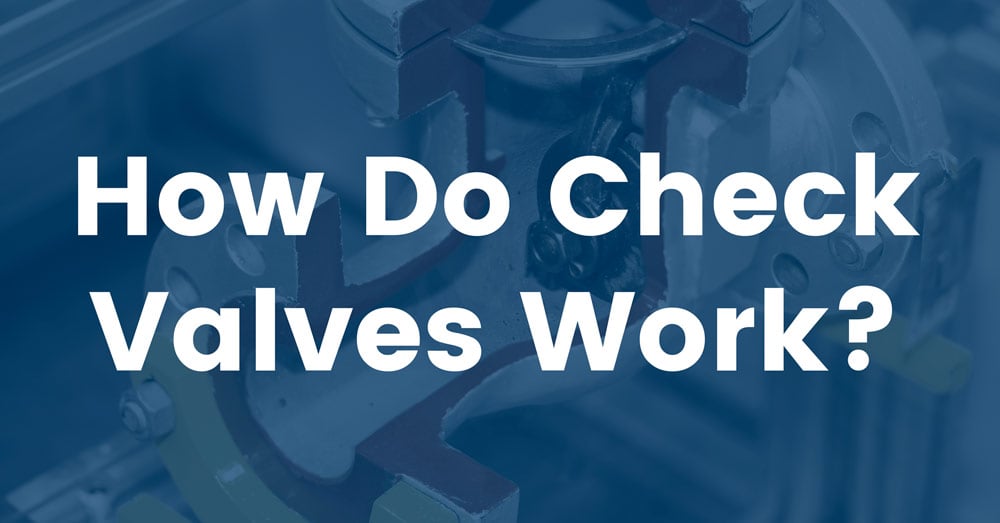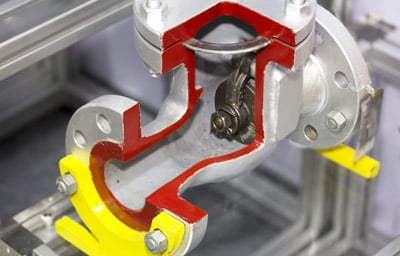How Do Pump Check Valves Work?

A pump check valve is a self-actuating, one-way or non-return valve. This automatic safety device allows fluids to flow freely in one direction. However, if the fluid flow is reversed, the valve will automatically close, thus protecting the connected piping and pump.
Why Check Valves Are Important
Check valves are important because they prevent backflow, which can cause water hammer. Backflow propagates a surge of pressure or induces a high-pressure shock wave throughout the piping system which can reach spikes as high as ten times the safe operating pressure for the pipe. Although a single occurrence of water hammer may not cause immediate failure, repeated extreme forces cause fatigue and may cause critical damage to the connected pump and piping.
Apart from protection, check valves also ensure that fluid flows in the intended direction and prevents backflows or leaks by forming a tight seal.
How Do Pump Check Valves Work?
 Check valves are self-actuating devices, which means that their opening and closing operations require no human involvement. Instead, their operation is a function of pressure differential. There are various types of check valves available in the market, but let’s consider a single disk check valve as an example to understand the working principle.
Check valves are self-actuating devices, which means that their opening and closing operations require no human involvement. Instead, their operation is a function of pressure differential. There are various types of check valves available in the market, but let’s consider a single disk check valve as an example to understand the working principle.
In this type of check valve, fluid under pressure enters the valve from the inlet. This pressure automatically opens the disk of the valve, and it stays open until the pressure drops. As the pressure decreases, the disk slams shut and closes the valve.
An important aspect to consider here is the cracking pressure of a check valve. It is a pressure that opens the disk of the valve, allowing the fluid to flow through. Cracking pressure can range from 3 psi to 350 psi, depending upon the size and application of the check valve.
How to Select the Right Check Valve?
Many factors should be considered in choosing a check valve for your specific application. For example, some industries require a valve that allows for a flow of abrasive fluids, while others require a valve that does not rust.
Some primary factors to consider are:
- The orientation of the valve (i.e. vertical or horizontal)
- Size of pipe
- Pressure intensity
- Minimum acceptable leakage rate
Apart from these factors, check valves are specified based on the largest possible valve flow coefficient (Cv). The higher the Cv, the higher is the pressure required to open the valve gates.
So, if a higher Cv valve is used for a low-pressure application, the valve gates would only open partially. As a result, there will be an increase in fluid flow resistance and pressure drop. A higher valve flow coefficient will also increase the chances of a phenomenon called valve flutter, increasing component wear and eventually failing the component.
Applications of Check Valves
Check valves are used in many different industries for a varied range of applications, including:
- HVACs for ensuring no backflow of coolants
- Chemical Industries
- Food Processing Industries
- Water and Wastewater Treatment
- Industrial, marine and mining pumps
- Power generation
Check valves are often placed at the outlet end of a centrifugal pump to safeguard the pump from backflow. Since centrifugal pumps are not self-priming, check valves are also helpful in retaining fluids in the pipes. In water treatment plants, check valves are often installed in series to prevent the backflow contamination of pipes carrying clean water.
Commonly Used Pump Check Valves
Larger pump check valves are commonly designed to have a metal disk swing or pivot on a hinge to shut the valve for preventing the backflow of fluids.
Smaller pump check valves often have a wider variety in available design, such as manually actuated ball valves or a spring ball valve that features a spring-loaded ball that shuts the valve.
Duckbill check valves feature a rubber diaphragm that opens and closes with the application of pressure.
Keep A Check On Your Check Valves
Check valves are essential to help maintain fluid pressure and also prevent backflow and water hammers. A failing check valve will first begin to vibrate and eventually lead to excessive component wear and damage.
One of the ways you can prevent this valve from failing and ensure longevity is through regular maintenance. Some of the preventive maintenance steps include:
- Keeping the valves and pipelines clean
- Lubricate the moving parts of the valve regularly
- Choose the right size and type of valve specific to your application
- Replace the faulty valves if you begin noticing the first signs of failure
At Hayes pump, our pump maintenance programs backed by fully trained personnel can keep your pumps operating at prime efficiency, with minimum downtime. Reach out to us for your pump maintenance and repair needs today!




